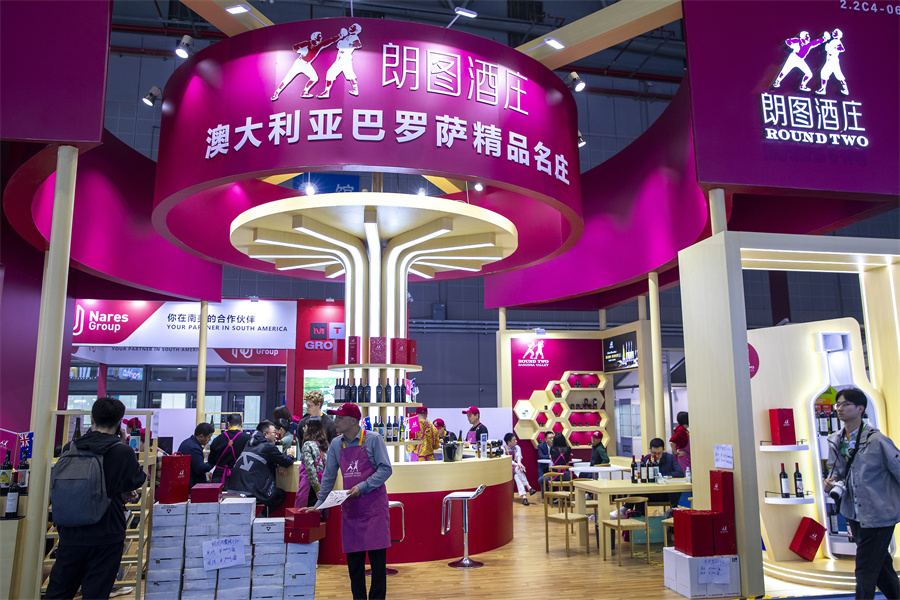
A view of the Australian wine exhibition area at the 7th China International Import Expo in Shanghai in November. [CHINA DAILY]
A rebound in demand from the Chinese mainland has driven a strong recovery in Australian wine exports, with total export value surging 34 percent year-on-year to 2.55 billion Australian dollars ($1.62 billion) in 2024, according to Wine Australia.
The Chinese mainland played a pivotal role in this rebound after the country lifted tariffs on Australian bottled wine at the end of March 2024, according to a report from Wine Australia, the country's grape and wine sector's statutory body for research, innovation, marketing and regulation.
In the following nine months, 83 million liters of Australian wine — valued at AU$902 million — were shipped to the market, making it the primary driver of growth. Exports to China accounted for 35.61 percent of total exports by value.
The average export price to the Chinese mainland market last year reached AU$10.79 per liter, pushing the overall value of packaged wine exports to a record AU$9.35 per liter, which is up 24 percent year-on-year.
Peter Bailey, manager of market insights at Wine Australia, said: "While there has been month-to-month volatility in the value of shipments to the Chinese mainland in the period since tariffs were removed, the performance is nonetheless very positive."
The market rebound has also reshaped the composition of Australian wine exports. Red wine now accounts for 93 percent of Australian wine shipments to China, increasing its share of total exports from 54 percent to 60 percent in volume in 2024. Meanwhile, white wine lost market share, declining from 46 percent to 40 percent due to weaker demand in Australia's key white wine export destinations.
As a result, Australia's top red wine varietals — Shiraz, Cabernet Sauvignon and Merlot — all saw increased export volumes, while leading white varieties — Chardonnay, Pinot Gris/Grigio and Sauvignon Blanc — declined.
The report said global alcohol consumption is facing numerous headwinds. In many established wine markets, consumption is declining due to health and wellness concerns and the rising cost of living. This has contributed to a global oversupply of wine and increased competition in already strained supply chains.
Australian wine exports to the rest of the world declined by 13 percent in value to AU$1.64 billion and 7 percent in volume to 565 million liters in 2024.
The Chinese market was a key driver of growth for Treasury Wine Estates, a leading wine producer in Australia. The company delivered strong financial results for the first half of fiscal 2025.
Net profit after tax rose 32.5 percent to AU$220.9 million, while earnings before interest, tax, and self-generating and regenerating assets surged 35.1 percent to AU$391.4 million. The strong performance was fueled by its luxury portfolio, particularly Penfolds, as well as the contribution from DAOU.
Demand for Penfolds has been robust, with depletion performance in the December quarter marking a return to pre-tariff levels last seen in the interim report. The Penfolds Bin and Icon portfolio, in particular, recorded double-digit growth across all distribution channels. The e-commerce sales of the two brands soared 72 percent over the same period.
Penfolds reported a 33.9 percent increase in EBITS to AU$250.2 million, with its EBITS margin expanding 3.2 percentage points to 44.9 percent. Growth was driven by strong demand in Asia, particularly in China, where the resumption of Australian shipments has been well received by consumers, according to the interim 2025 report.
Brand health metrics for Penfolds in China continue to improve, with rising awareness and consumption, reflecting the effectiveness of TWE's targeted investments and distribution strategy, said the company.
While overall alcoholic beverage market conditions in China remain mixed, the wine category showed positive momentum in the first half of fiscal 2025, particularly in the December quarter, said the company. The company has seen the value of its wine category grow 6 percent during the period, driven by Penfolds. E-commerce, which now accounts for about 20 percent of Penfolds' retail sales in China, was a bright spot.
TWE remains confident in the long-term growth potential of Penfolds in the Chinese market.
TWE Chief Executive Officer Tim Ford said: "We are extremely pleased to have successfully re-established the Penfolds Australian country-of-origin portfolio in China, with positive consumer and customer sentiment evident in key performance signals."